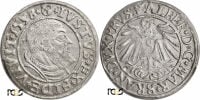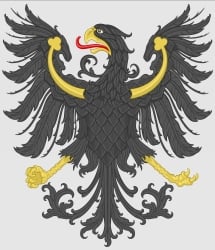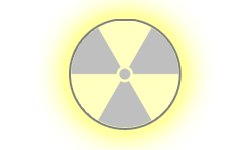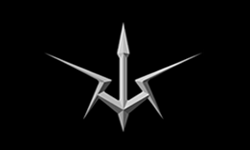| National Factbook |
| Flag: |

|
| Nation Name: |
Herzogtum Preussen |
| Leader Name: |
Albrecht I |
| Currency: |

Thaler |
| National Animal: |

Prussian Eagle |
| History: |
The duchy became the first Protestant state when Albert, Duke of Prussia formally adopted Lutheranism in 1525. It was inhabited by a German, Polish (mainly in Masuria), and Lithuanian-speaking (mainly in Lithuania Minor) population.
In 1525, during the Protestant Reformation, in accordance to the Treaty of Kraków, the Grand Master of the Teutonic Knights, Albert, secularized the order's prevailing Prussian territory (the Monastic Prussia), becoming Albert, Duke of Prussia. As the region had been a part of the Kingdom of Poland since the Second Peace of Thorn (1466), King of Poland Sigismund I the Old, as its suzerain, granted the territory as a hereditary fief of Poland to Duke Albert per the Treaty of Kraków, a decision that was sealed by the Prussian Homage in Kraków in April 1525. The new duke established Lutheranism as the first Protestant state church. The capital remained in Königsberg (modern Kaliningrad).
The duchy was inherited by the Hohenzollern prince-electors of Brandenburg in 1618. This personal union is referred to as Brandenburg-Prussia. Frederick William, the "Great Elector" of Brandenburg, achieved full sovereignty over the duchy under the 1657 Treaty of Wehlau, confirmed in the 1660 Treaty of Oliva. In the following years, attempts were made to return to Polish suzerainty, especially by the capital city of Königsberg, whose burghers rejected the treaties and viewed the region as part of Poland. The Duchy of Prussia was elevated to a kingdom in 1701. |
| Geography |
| Continent: |
Europe |
| Land Area: |
32,186.80 sq. km |
| Terrain: |
Prussia presents a varied and often stark landscape shaped by ancient glaciers, the Baltic Sea, and dense medieval settlement patterns. Much of the terrain consists of gently rolling plains, interrupted by low, forested hills and winding rivers. The land is fertile in the south and west, where sandy-loamy soils support grain agriculture, especially rye, barley, and oats. Farms and small villages cluster around manorial estates, often remnants of the old Teutonic Order’s holdings.
To the north, the terrain flattens as it nears the coastline of the Baltic Sea. This area is marked by dunes, marshes, and lagoons—especially around the Vistula Lagoon and Curonian Spit—where brackish waters blend into the land. Fishing villages and modest ports dot the coast, their people dependent on both the sea and the land.
Large patches of ancient forest dominate the landscape inland—oak, beech, and pine forming dense canopies that house deer, boar, and wolves. These woods are sometimes broken by clearings or peat bogs, and crisscrossed with rough paths rather than true roads. Swamps and wetlands are common in the lowlands, especially along the Pregel and Łyna rivers, making travel slow and treacherous outside established routes.
Castles, towns, and churches sit atop the occasional ridge or river bend, commanding the landscape like watchful sentinels. Königsberg, the capital, lies near the coast along the Pregel River, surrounded by a patchwork of fields, woodlands, and watercourses. The region’s flatness and exposure to northern winds lend it a cool, damp climate, with long winters and brief, humid summers. |
| Highest Peak: |
Kernsdorfer Hohe, 312 meters |
| Lowest Valley: |
Elchniederung, 17 meters |
| Climate: |
Prussia is cool, damp, and strongly seasonal, shaped by its position along the southeastern Baltic coast. Winters are long, cold, and often harsh. Snow blankets the countryside from late November to March, especially inland, where continental influences dominate. Frozen rivers and icy winds from the northeast make travel and farming difficult during these months. Ice may cover the shallower parts of the Baltic, isolating ports and halting sea trade.
Spring arrives slowly, with March and April often muddy and unpredictable. Thaws swell rivers and flood lowlands, while late frosts still threaten early crops. The region comes alive with green, but warmth builds gradually.
Summers are mild and relatively short. Temperatures rarely rise above the low 20s Celsius (70s Fahrenheit), and nights remain cool. Rain is frequent but not constant, falling in short, sometimes violent bursts. Humidity rises near the coast, and fog can roll in from the Baltic, especially in the mornings. Inland, the warmth is more stable, allowing for productive agriculture during these crucial months.
Autumn is brief and wet, with winds growing stronger and daylight diminishing quickly. Trees turn golden and red across the forests, but chill returns by late October. Heavy rains soak the fields, making harvest time a race against worsening weather. |
| People & Society |
| Population: |
2,222,879 people |
| Demonym: |
Prussian |
| Demonym Plural: |
Prussians |
| Ethnic Groups: |
German - 51.0%
Polish - 26.0%
Lithuanian - 19.0% |
| Languages: |
German - 51.0%
Polish - 26.0%
Lithuanian - 19.0% |
| Religions: |
Lutheranism - 76.0%
Protestantism - 15.0%
Catholicism - 9.0% |
| Health |
| Life Expectancy: |
72 years |
| Obesity: |
3.6% |
| Alcohol Users: |
76.9% |
| Tobacco Users: |
12.3% |
| Cannabis Users: |
0% |
| Hard Drug Users: |
0% |
| Economy |
| Description: |
Prussia emerges as a modern industrial powerhouse—an advanced, mechanized state operating under the veneer of Renaissance-era politics. The economy is highly diversified and export-driven, centered around heavy industry, advanced manufacturing, and resource processing. Massive steelworks in Königsberg and Elbing dominate the urban skylines, powered by coal from rich eastern deposits and hydroelectric stations along the Pregel and Łyna rivers.
Agriculture, once the backbone of the economy, is now mechanized and efficient. Autonomous plows and harvesters roam the vast fields of rye, barley, and flax, monitored by agritechnicians from regional control centers. Food surpluses are processed, packaged, and shipped across Europe, while biofuel crops help power rural industry. Rural laborers are replaced by technicians and logistics managers, and the old feudal estates have transformed into agribusiness conglomerates.
The Baltic coast fuels a booming maritime economy. Königsberg’s modern port is a key node in international shipping, handling everything from containerized goods to liquid natural gas. Advanced shipyards produce both cargo vessels and naval fleets, combining centuries of seafaring tradition with cutting-edge engineering. Coastal towns thrive on aquaculture, fish processing, and oceanic research.
Technology and innovation are central. Ducal Prussia invests heavily in research, with universities like the Albertina acting as hubs for engineering, robotics, and applied sciences. Start-ups and state-backed firms produce everything from high-speed rail components to aerospace materials. Industrial parks dot the countryside, linked by electrified highways and maglev corridors. Königsberg itself is a city of factories, laboratories, and data centers—its skyline lit by solar arrays and wind turbines.
Finance flows through modern banks in Marienburg and Königsberg, managing investments, state bonds, and international trade deals. The ducal administration runs a streamlined technocratic state, using data-driven planning and AI-assisted economic policy to maintain growth, control inflation, and balance trade. Cryptocurrency equivalents and digital credits circulate alongside traditional coinage, and even peasant descendants manage portfolios on state-backed economic apps.
Meanwhile, exports define Prussia’s global presence. Steel, chemicals, advanced optics, precision tools, and processed foodstuffs dominate its shipping manifests. Trade agreements with France, Poland, and Muscovy fuel constant movement through high-speed rail links and cargo ports, while tariffs and subsidies maintain domestic stability. |
| Average Yearly Income: |
$214.27 |
| Gross Domestic Product (GDP): |
$5,332,843,727.00 |
| GDP per Capita: |
$2,399.07 |
| Gross National Income (GNI): |
$4,055,722,685.00 |
| Industries: |
Steel mills dominate cities like Königsberg and Elbing, where blast furnaces churn day and night, powered by local coal and hydroelectric energy. The region produces high-grade steel and iron, feeding a vast network of factories. These materials support construction, shipbuilding, weapon manufacturing, and emerging machine tool industries. Foundries cast precision parts for everything from railways to armaments, while metallurgists pioneer alloys that outperform traditional mixes.
Factories produce complex machinery—automated looms, steam engines, and early mechanized farming equipment. Assembly lines hum with activity as skilled workers and engineers build everything from textile machines to clockworks and rudimentary robotics. This sector fuels both domestic needs and lucrative exports, supplying neighboring powers with tools and technology that advance their own industries.
Situated on the Baltic coast, Ducal Prussia’s shipyards construct large cargo vessels, warships, and advanced sailing ships outfitted with iron reinforcements and early steam-assisted engines. Dry docks and repair yards support a bustling maritime economy, servicing fishing fleets and merchant convoys. Ports like Königsberg thrive with shipbuilding suppliers, rope makers, sail makers, and salt processing plants critical to preserving fish and goods.
The rise of chemical industries supports agriculture and manufacturing. Factories produce fertilizers to boost crop yields and basic industrial chemicals used in tanning, textiles, and glassmaking. Innovations in distillation and extraction techniques enable the manufacture of dyes, medicines, and early explosives, fueling both civilian industries and military applications.
Prussia’s textile mills operate mechanized looms spinning flax and wool grown in the countryside. Skilled weavers produce fine fabrics—linen, coarse woolens, and emerging blends for export. Dye workshops utilize natural and chemically enhanced pigments, giving Prussian textiles a distinct quality prized in European markets. Garment factories begin assembling clothes on an industrial scale, supporting both local demand and trade.
Agriculture remains vital but is mechanized and systematized. Large estates function like agro-industrial complexes, combining mechanized harvesting, processing, and packaging. Flour mills and breweries benefit from improved grain yields, producing staple foodstuffs and beverages at scale. Cold storage and transport systems keep produce fresh for export, connecting rural producers to urban markets.
Hydroelectric plants along rivers, coal-fired power stations, and early experiments with wind power supply energy to factories and cities. Railways and paved roads crisscross the duchy, enabling rapid movement of goods and people. Industrial engineers maintain complex logistics networks, managing supply chains from raw materials to finished products.
Research institutions and universities fuel innovation, supporting applied sciences that drive industrial progress. Optical instrument makers, clockmakers, and early electrical engineers create precision devices used in navigation, military equipment, and communications. Workshops produce lenses, telescopes, and scientific apparatus, blending artisanal skill with industrial production. |
| Military |
| History: |
Prussia commands a military force that stands as a modern powerhouse—highly disciplined, technologically advanced, and strategically sophisticated. The military integrates cutting-edge industrial production with rigorous training, transforming the duchy’s forces into a dominant land and naval power in Northern Europe.
The core of Ducal Prussia’s military is a large, professional standing army equipped with advanced weaponry and mechanized support. Infantry units wield early firearms—matchlock arquebuses and wheellocks—produced en masse in state-of-the-art arms factories. Soldiers wear standardized uniforms reinforced with steel cuirasses and helmets designed to balance protection with mobility. Artillery regiments operate powerful cannons and mortars, mass-produced with precision engineering for superior range and accuracy. Mechanized transport, including horse-drawn wagons and experimental steam-powered vehicles, supports rapid troop movement and supply logistics.
Prussia’s military doctrine emphasizes discipline, coordination, and innovation. Units train extensively in volley fire tactics and combined arms maneuvers, integrating infantry, cavalry, and artillery seamlessly on the battlefield. Elite guard regiments serve both as shock troops and as protectors of the duke and key fortresses. Engineering corps excel in building fortifications, siege equipment, and rapidly repairing damaged infrastructure, backed by military academies focused on applied science and engineering.
Ducal Prussia boasts a formidable Baltic fleet, anchored in Königsberg and Elbing, blending traditional sail with early steam-assisted propulsion. Shipyards churn out heavily armed warships—galleons and frigates reinforced with iron plating and outfitted with broadside cannons and swivel guns. The navy maintains fast, maneuverable frigates for reconnaissance and escort duties, alongside larger ships of the line projecting power across the Baltic Sea. Coastal defenses include fortified ports with shore batteries connected to an advanced early-warning network using signal towers and semaphore communications.
The navy protects trade routes critical to Prussia’s economy, enforces maritime law, and projects force in the region. Naval infantry units specialize in amphibious operations, boarding actions, and coastal raids, trained in coordination with the army for combined operations.
While true heavier-than-air flight remains centuries away, Ducal Prussia pioneers early aerial reconnaissance using tethered hot-air balloons and gliders. These provide battlefield observation and mapping advantages, feeding real-time intelligence to commanders. Signal corps employ semaphore lines and courier networks to ensure rapid communication across dispersed forces.
The backbone of Prussia’s military power is its industrial complex. Arms factories produce standardized muskets, pikes, cannon, and uniforms with remarkable efficiency, supported by a vast supply chain ensuring steady delivery of food, ammunition, and equipment. Rail lines and paved roads enable rapid redeployment of troops and matériel, while depots and arsenals maintain reserves to sustain prolonged campaigns.
Military leadership combines noble tradition with meritocratic principles. Officers receive rigorous education in tactics, engineering, and logistics, often trained at the duchy’s military academies. Strategic planning integrates geographic intelligence with emerging concepts of combined arms warfare, preparing forces for flexible response to threats on multiple fronts. |
| Soldiers: |
150,000 |
| Tanks: |
12,500 |
| Aircraft: |
750 |
| Ships: |
150 |
| Missiles: |
0 |
| Nuclear Weapons: |
0 |
| Last Updated: 06/30/2025 12:57 am |




















